By David Brackney
Hello there, and muchos saludos a todos! As some of you may recall, last year around this time my daughter and I took a spring break vacation to Guadalupe Canyon, located near Mexicali at the foot of the Sierra Juarez, and I shared the resulting photo essay.
We recently returned from another spring break trip, covering a large slice of northeastern Baja. Crossing the border at Mexicali, we headed first to San Felipe, then onward down the newly extended Mexico Hwy. 5, clear to Chapala Junction, where it meets Mexico Hwy. 1, deep in the Central Desert.
We weren’t done yet, though, as we continued to Bahía de los Ángeles, along the Sea of Cortez about 40 miles east of Hwy. 1. For those of you who’ve been there, you know “L.A. Bay” ranks with the greatest scenic highlights Baja has to offer.
I’ve compiled another photo essay this year, and once more I thought I’d share it with you.
I had a fortuitous run in my journalism career, the dozen years in the 1990s and 2000s when I got paid to take extended road trips, explore faraway destinations, take lots of pictures, and then share with the world what I had found. Those were my days as a travel journalist for the Auto Club of Southern California (AAA), and my chief assignment was Baja California, the iconic peninsula in Mexico that runs 800 miles south from the U.S. border to Cabo San Lucas.
I no longer work for the Club (they stopped making travel publications some years back), but I never forgot about Baja, and in recent years I’ve taken several trips there with my younger daughter Emily. That included our recent spring break trek to the desert northeast of Baja, which Emily had not been to before.
Early spring is a great time to visit here, as the days grow long and the weather warms up, but summer’s worst heat is still months off. Even so, through most of our trip we largely missed the crowds.
We skipped the Pacific coast altogether, instead crossing the California desert to the twin border communities of Calexico and Mexicali. From there we made the straight shot to the Sea of Cortez, starting with the boisterous beach town of San Felipe, then onward down the scenic shoreline into the central desert, winding up at the remote seaside town of Bahía de los Ángeles.
A decade-plus had passed since my last trip through this part of Baja, so I had some new things to check out. The biggest change is the newly extended Mexico Hwy. 5, which once stopped an hour’s drive south of San Felipe but now runs clear to Mex. Hwy. 1, deep in the central desert. It opened in late 2020, replacing the rock-strewn, ungraded dirt road that took its toll on even the sturdiest of off-road rigs.
We did some off-road exploring along the way, although that wasn’t the main focus. If it were just me, I could spend weeks driving those dusty back routes, just as I once did for the Club. However, I don’t think Emily would be up for that (she’s normal that way!), and we lead busy lives back home. But we made the most of our six-day trek, heading home the same way we came.
I look forward to our next trip south, and I hope this compilation, including fully captioned photos, was worth the effort.
David Brackney is a former travel journalist who worked for the Auto Club of Southern California from 1996 to 2008. He authored several guidebooks and guide maps on Baja, plus other destinations around the U.S. and Mexico. Before that he spent seven years living in Mexico City, working as a writer and editor at a pair of English-language newspapers.
Although his travel journalism days are behind him (at least for now), David still loves hitting the road when he can and has a smile on his face whenever he crosses the border to Mexico. He’s also active in Club Dust, an Orange County-based group that builds homes and provides basic living supplies for impoverished families living in the Tijuana-Tecate area. A Southern California native, he lives in Whittier with his two daughters.
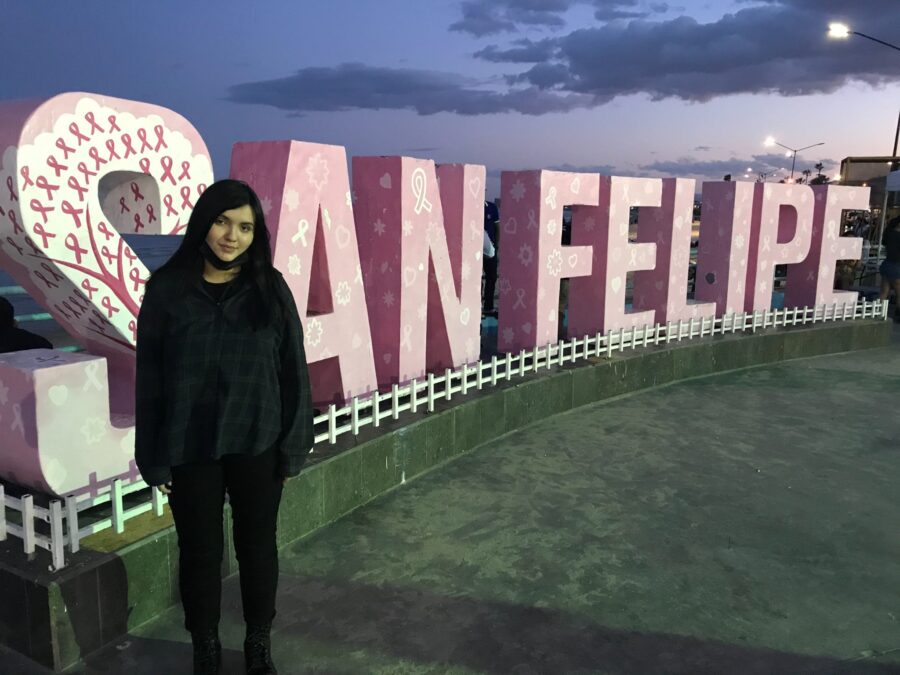
Guess if you can where we made our first stop in Baja—that venerable resort town near the north edge of the Sea of Cortez. Interesting thing… in the last decade or so, all Mexican towns—from Mexico City on down to the tiniest village—have erected big, block-letter signs like this. In most cases, they’re a lot brighter than the muted pink we see here. The SF sign is located on the “malecón” (seafront walkway), where Emily provides a sense of scale.
Update: Someone visited San Felipe after our trip and sent me a more recent photo of this sign, completely repainted in a bright new color scheme. And upon further review, it appears the pink paint job here may have been part of a breast cancer awareness campaign.
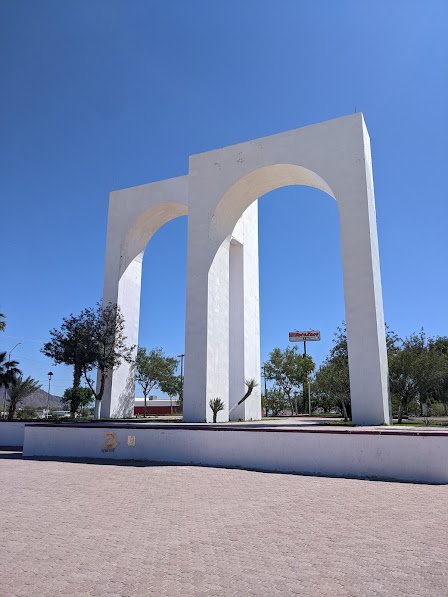
The twin arches at the north end of town are San Felipe’s signature landmark, and this essay would not be complete without a picture of them, so here you go.
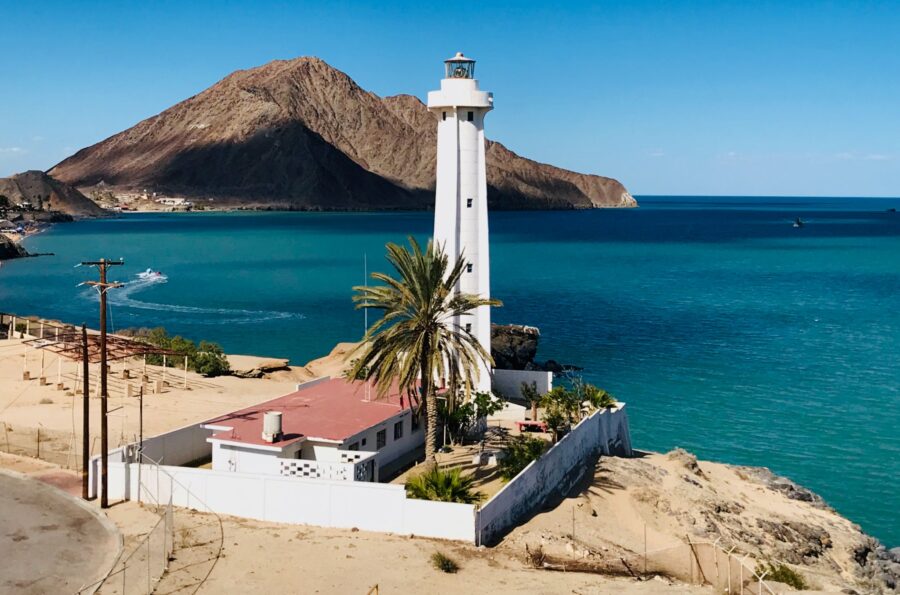
San Felipe’s signature photo op would be this view of the local lighthouse with Punta San Felipe in the distance. I took a pic from this same vantage point in 2006 that eventually appeared on the cover of the Auto Club’s Baja California map.
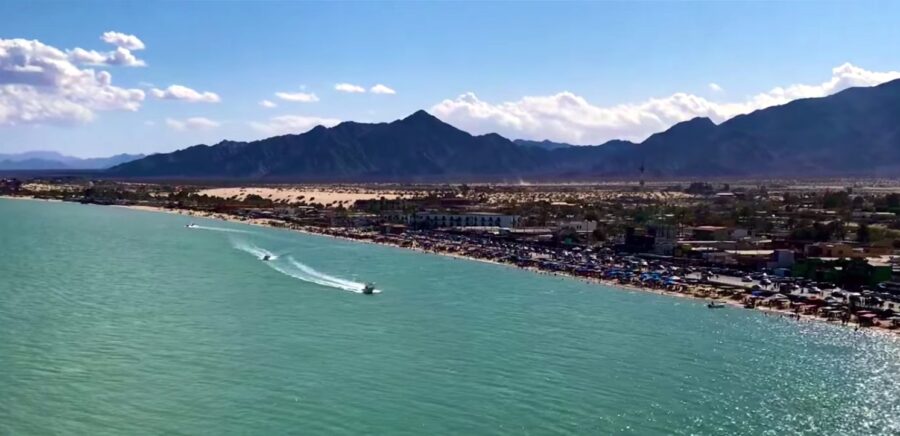
Looking south along the San Felipe shoreline on a gorgeous March afternoon. This town is a popular destination for folks from both sides of the border, but on this Saturday the Mexicans ruled the sea and sand. It was a three-day weekend, as Mexico celebrated Benito Juarez’s birthday and the sand was packed with happy “turistas,” who were clearly enjoying their time off. I’m guessing most came from Mexicali, the Baja California state capital, two hours to the north.
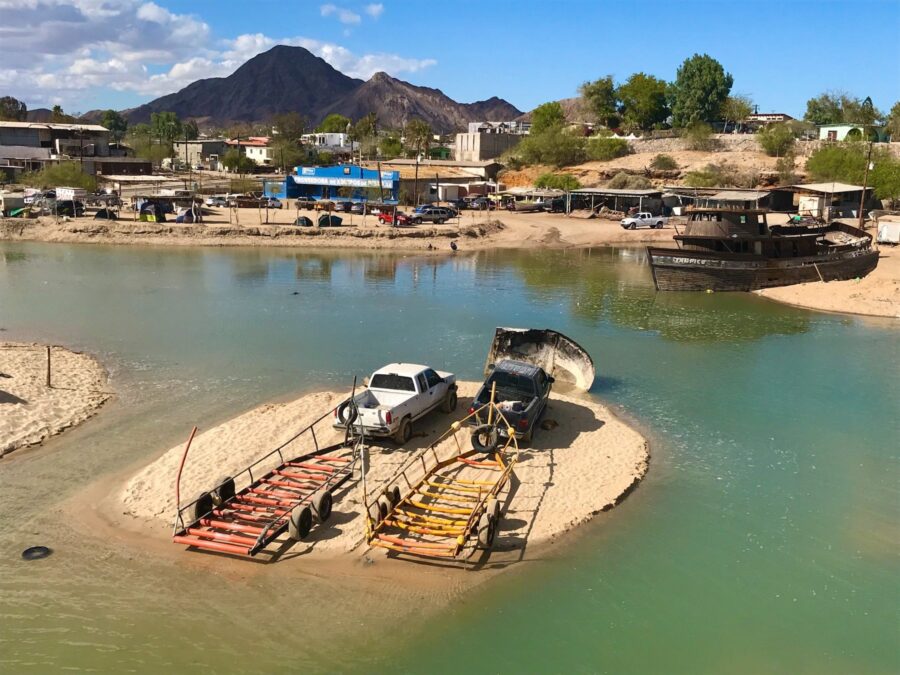
What the hey? How on earth did these pickups and their trailers wind up here? Just wait a few hours and you’ll find out, as the tide recedes and this lagoon runs completely dry. San Felipe has some of the largest tidal changes on earth—more than 20 vertical feet. I’m guessing the owners of these trucks were somewhere offshore in search of the catch of the day.
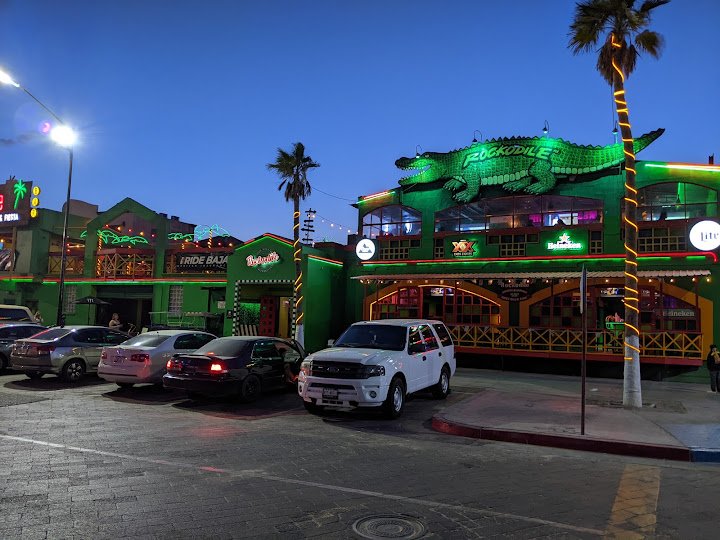
Ah yes, Rockodile… another San Felipe mainstay—an age-old destination for gringo and Mexican revelers looking for tasty eats, cold drinks and seaside carousing. Care to join them? It’s kind of hard to miss that big green sign on Paseo Cortez…
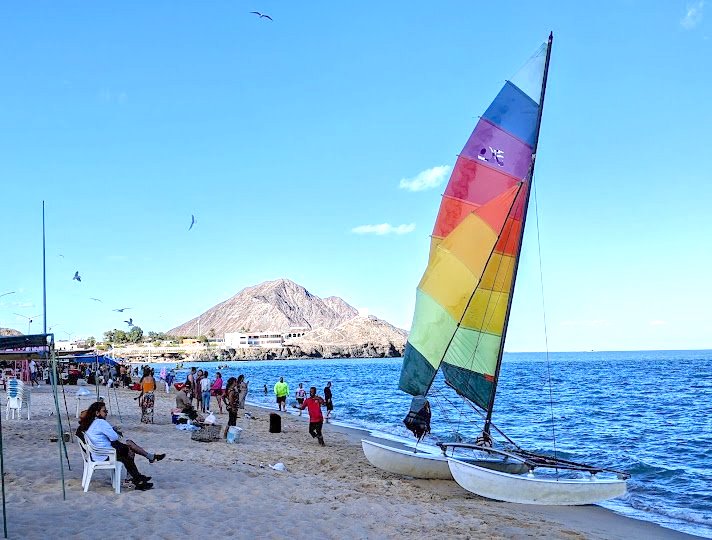
On the beach in San Felipe, just after someone parked their catamaran on the sand, adding an extra splash of color to this scene.
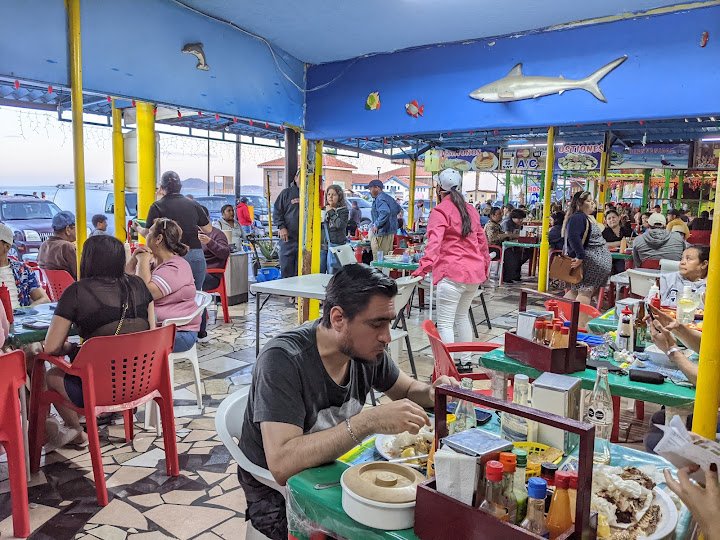
I’m not one to endorse restaurants or other tourist spots, but I do make exceptions, like Mariscos El Guero, this open-air restaurant on Paseo Cortez—sensibly priced fresh seafood next to the beach, with cheery (if not so fast) service. We were impressed enough to go back the next morning, and there too was the head waitress who’d served us the night before. From the size of that smile and strength of that hug, you’d think I’d left 100 bucks on the table the night before (if only). Where I come from, you expect speedy service, but never ever a greeting like that.
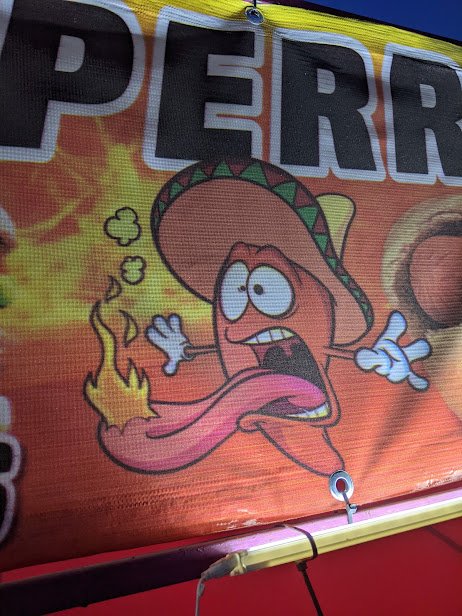
Sure, I’m good for a cheap laugh, like with this silly San Felipe hot dog stand sign. It just reminded me of my early run-ins with the fiery side of Mexican cuisine. I don’t get burned quite so often these days, but on occasion I do feel like this hapless character.
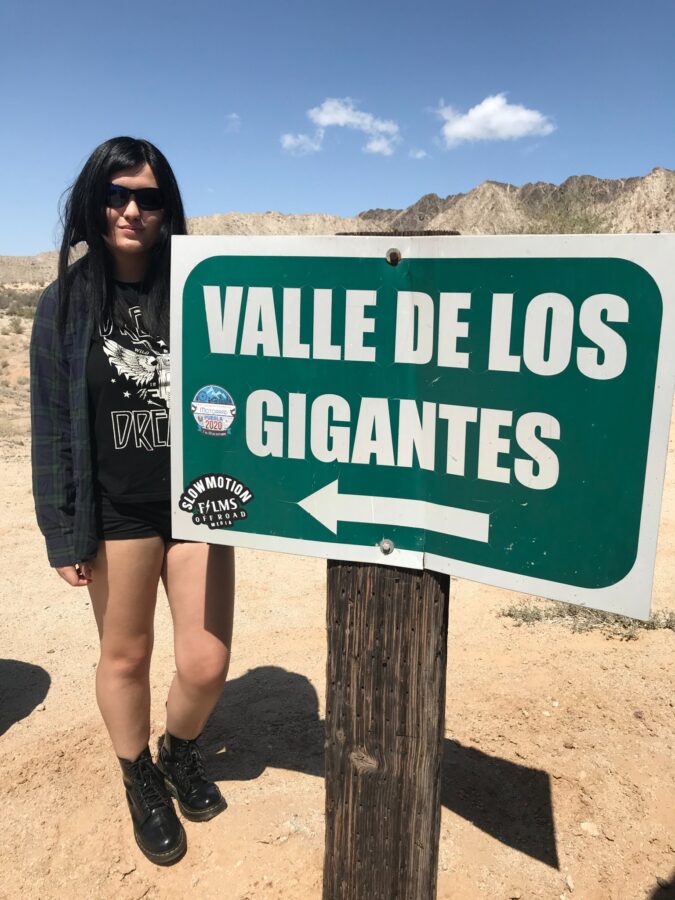
In case you didn’t take Spanish (or don’t have a gift for languages), this sign translates to mean “Valley of the Giants.” In this case the giants are cardón cacti—the bent-armed behemoths that cover so much of Baja’s deserts, cousins of the famed saguaros of Arizona and mainland Mexico. Some of the biggest cardones reside in this park, up to 60 feet (18 meters) tall. It’s about 20 miles (30 km.) south of San Felipe.
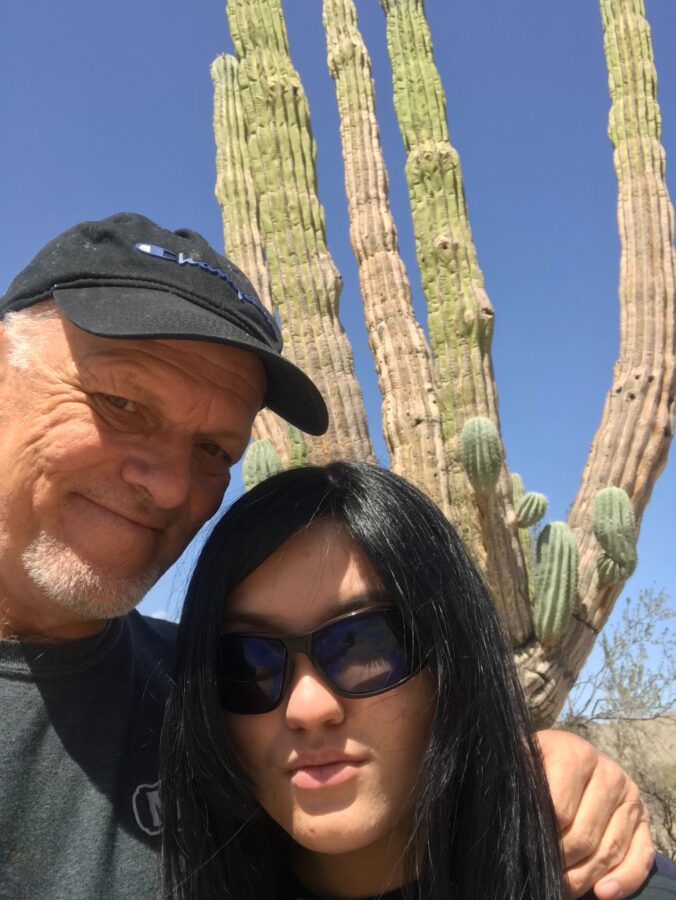
Self-portrait near the entrance of Valle de los Gigantes, with a good-sized cardón behind us. Entry fee was 200 pesos (about $10 USD) per vehicle.
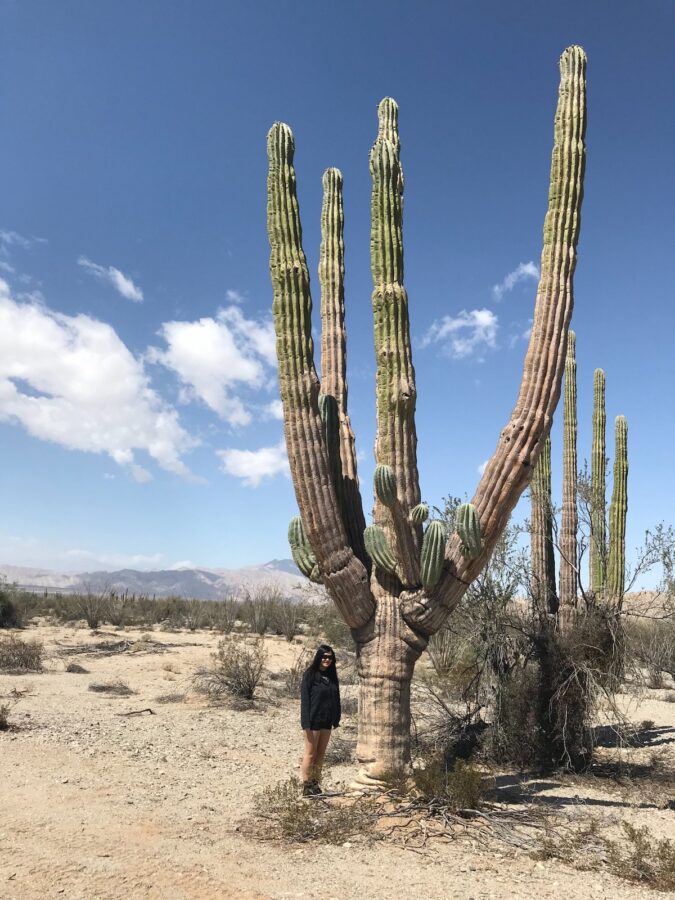
My Emily stands next to the base of a fair-sized cardón, Valle de los Gigantes.
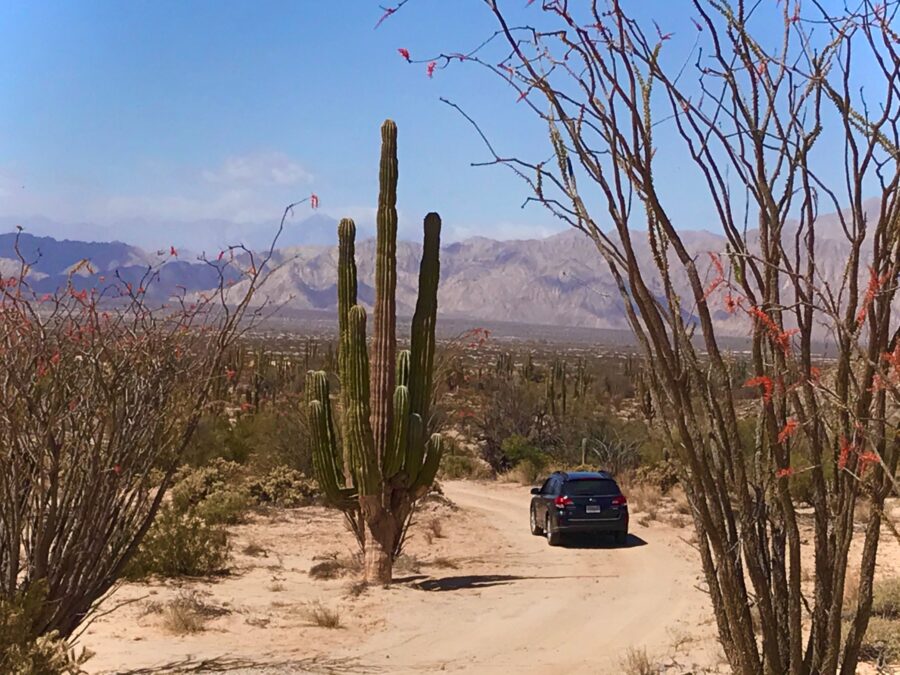
A nice view across Valle de los Gigantes. So that you know, passenger cars can only make it the first half-mile or so off the pavement; after that it’s the domain of four-wheel-drive and all-wheel-drive vehicles. The AWD Outback was up to the task, though I remain judicious when leaving the pavement behind. I still recall the day back in 1999 when my Club-issued Chevy Corsica sedan got bogged down in the sand in this same locale. I managed to get out of that jam after letting some of the air out of the tires. No harm, no foul, but a good story…
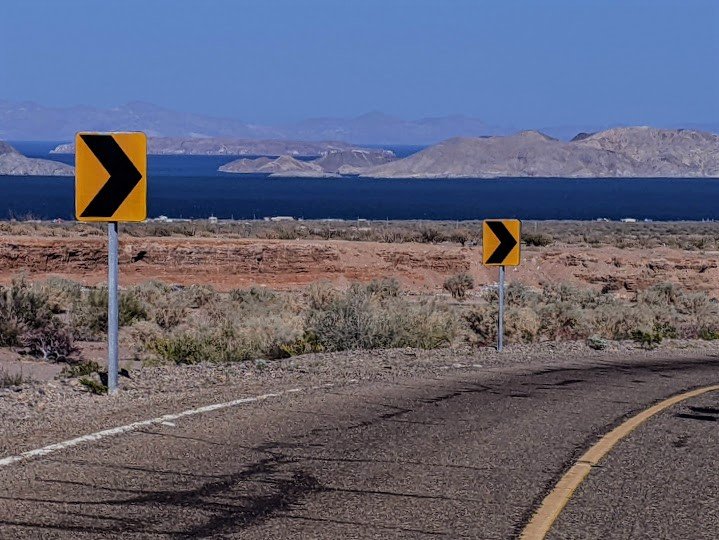
Four hours south of San Felipe and 40 miles (70 km.) east of the Mexico Hwy. 1, you round a bend in the road and there before you lies one of Baja’s grandest of views—that first look at Bahía de los Ángeles. “L.A. Bay,” as I call it for short, has few scenic equals in Baja, here on the Sea of Cortez with rugged desert isles that seem to float on the cobalt blue waters. The town here is home to around 1,200 souls, and fishing and tourism are the main industries.
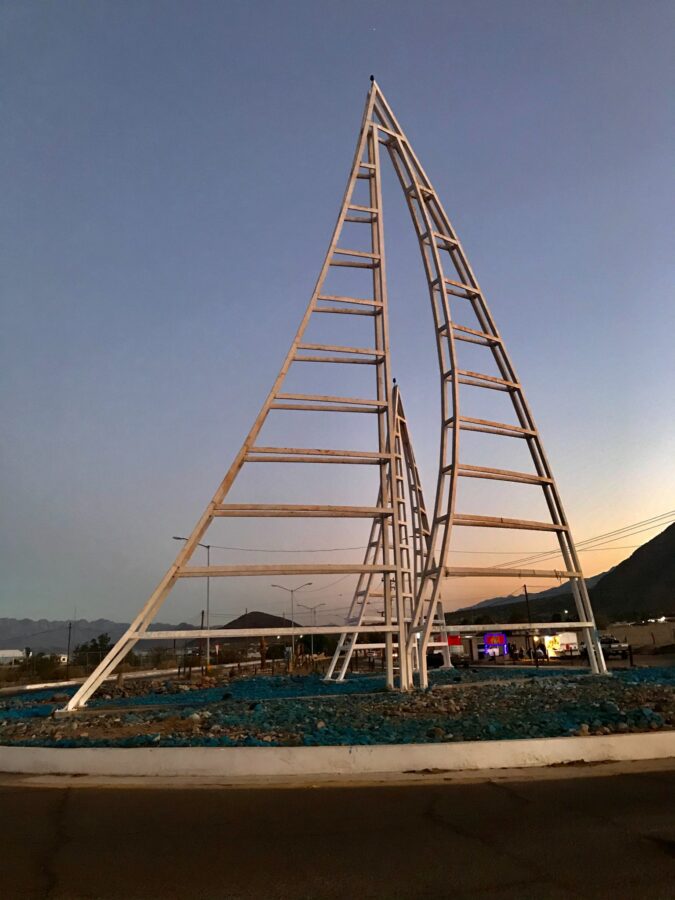
L.A. Bay has its signature landmark too—this sailboat sculpture near the town entrance. It’s located on the town’s sole roundabout, probably the only roundabout within hundreds of miles.
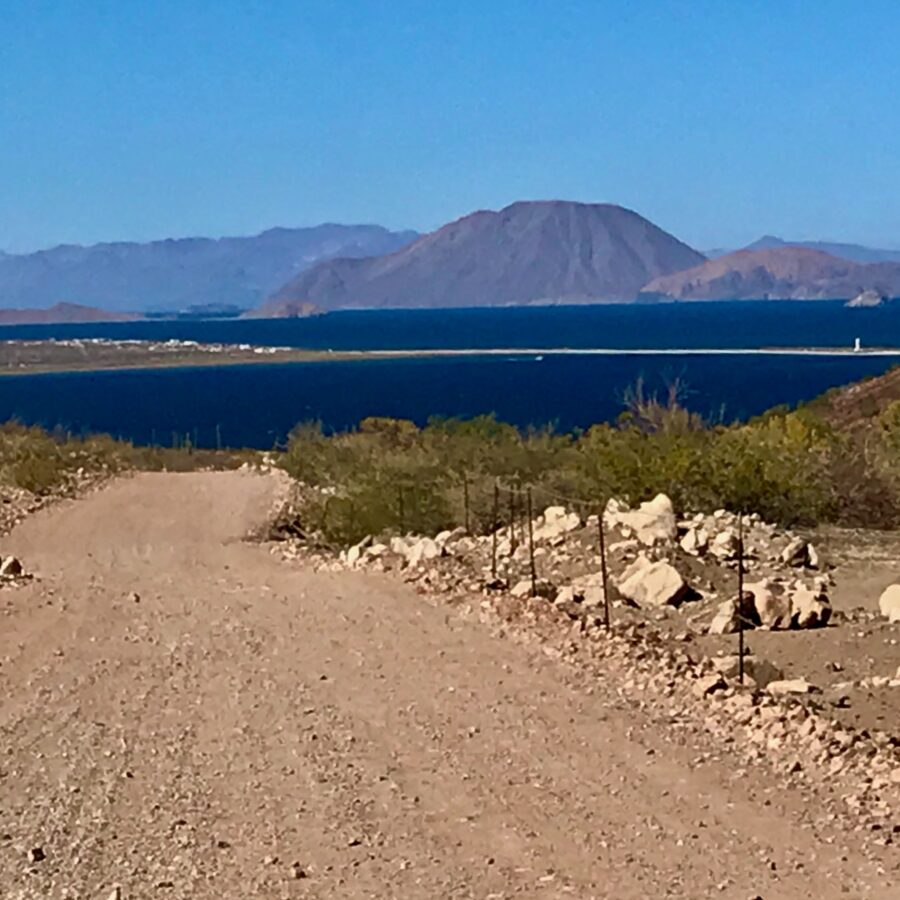
To me this photo represents classic Baja—a lonely dirt road bends its way toward a remote beachside destination—in this case L.A. Bay—with cobalt seas and desert peaks in the distance. The conical peak is on Isla Coronado, a dormant volcano a few miles north of town.
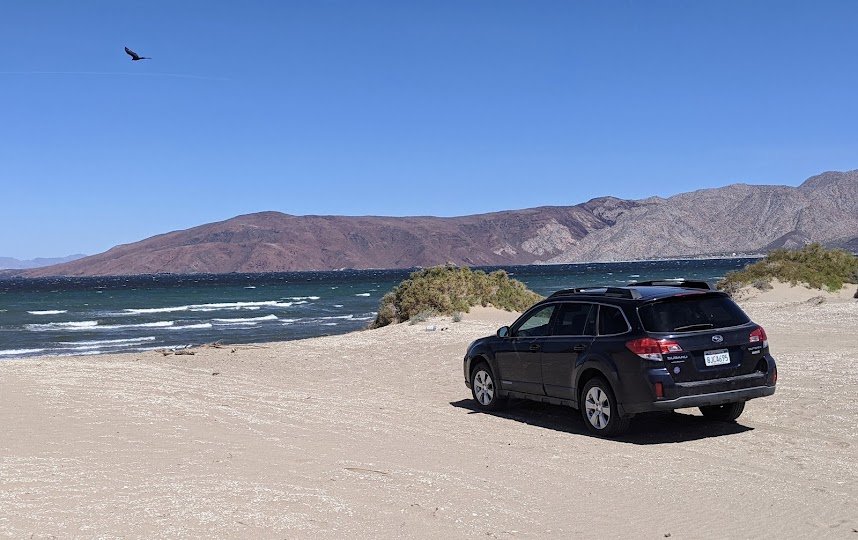
Like most of Baja, the best destinations at L.A. Bay are off road, like Playa Blanca (“White Beach”), about a 25-minute drive from the nearest pavement. We had the peaceful strand all to ourselves.
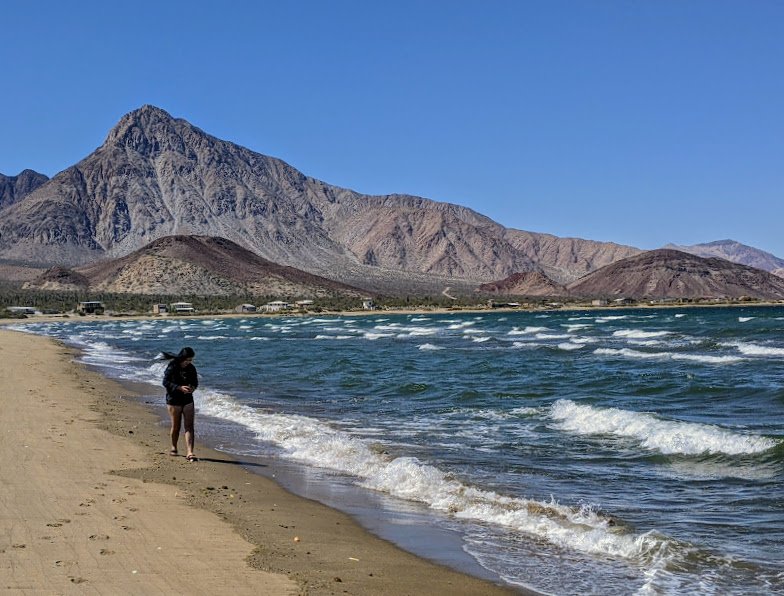
I always did like my home state California for its ready access to mountains, desert and seacoast within a short drive. But you have to come to Baja to find them all in the same place… on the sand at Playa Blanca.
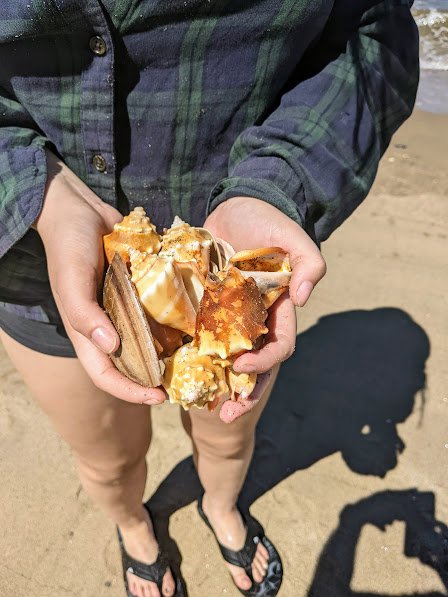
One way to know you’ve found an unspoiled beach is by the number of seashells on the sand. At Playa Blanca, beauties like these were everywhere.
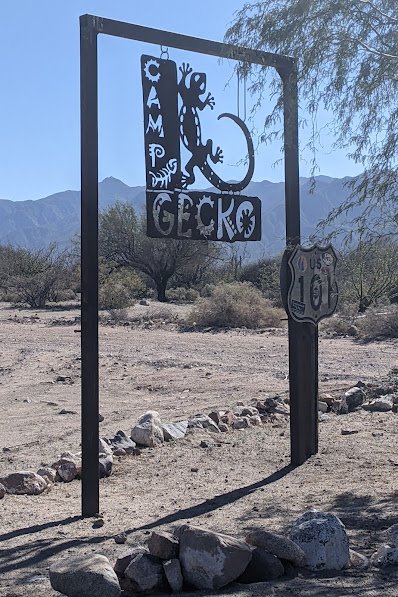
It had been a while since I last stopped at Camp Gecko, on the south shore of L.A. Bay. It’s not a “camp,” per se, but a community of small seaside dwellings, home mainly to U.S. and Canadian ex-pats who live here part- or full-time. There are scores of settlements like this along Baja’s coasts—most well-removed from the nearest town or even the nearest paved road. That may or may not be for you, but for a certain breed of gringo, it’s heaven on earth. In places like this, “no bad days” is the unofficial slogan.
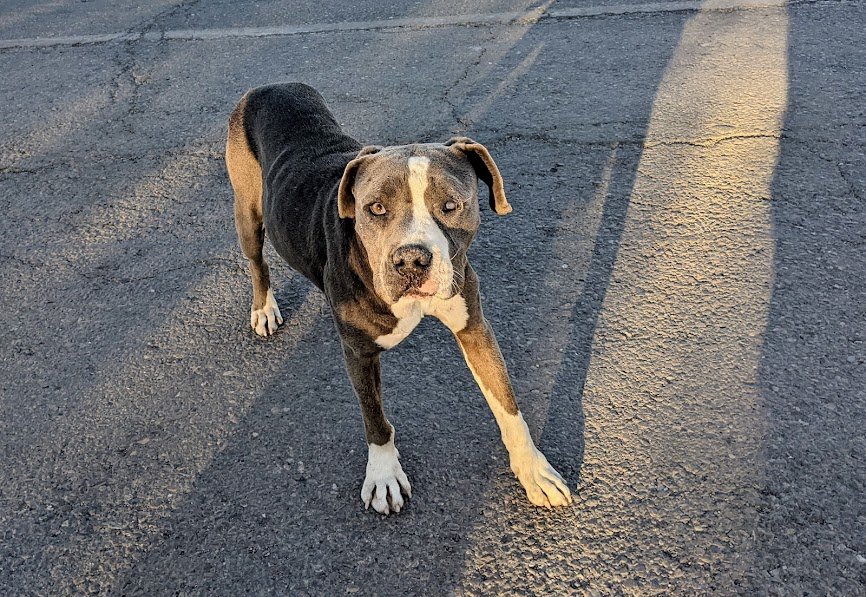
Street dogs are a fixture in Mexican townscapes, and Baja is no exception. This pit bull joined us as we walked to dinner one evening, as though he’d known us forever, and Emily promptly named him “Bibs.” Maybe too, we looked like easy marks, seeing how Bibs waited outside the restaurant clear through our dinner and was there when we walked out—Emily carrying a take-out bag with a half-eaten burger inside. One guess as to who finished that off…
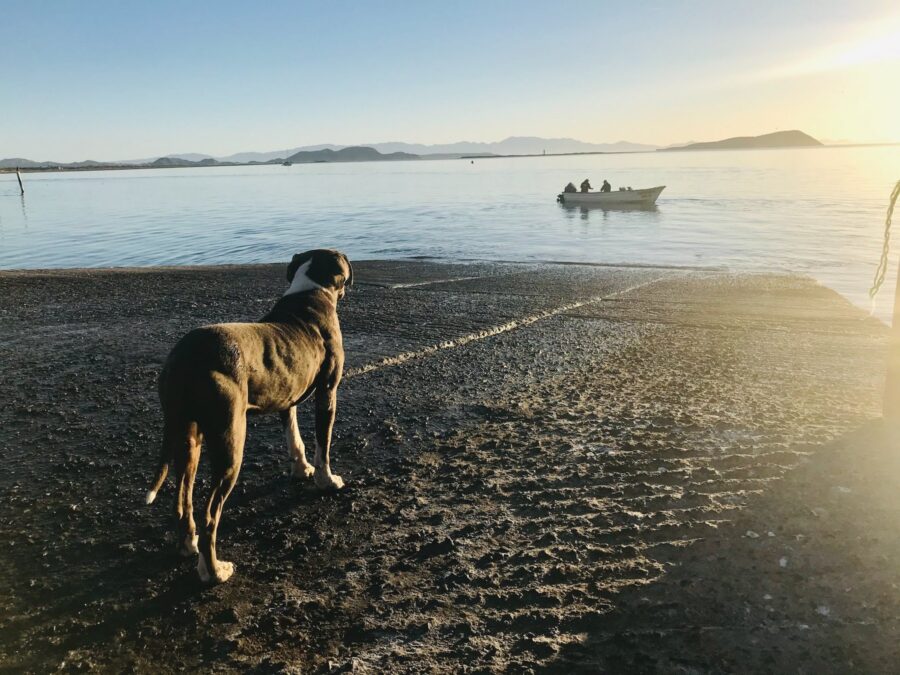
I thought we’d seen the last of Bibs, but nope, we met again the next morning when I headed out for some daybreak photos along the bay. I can’t be sure if he knew the guys in that boat, but he stood on that launch ramp for an awfully long time as they headed out to sea, so quite likely he did. And in small towns like this, everyone knows everyone else—two legs or four.
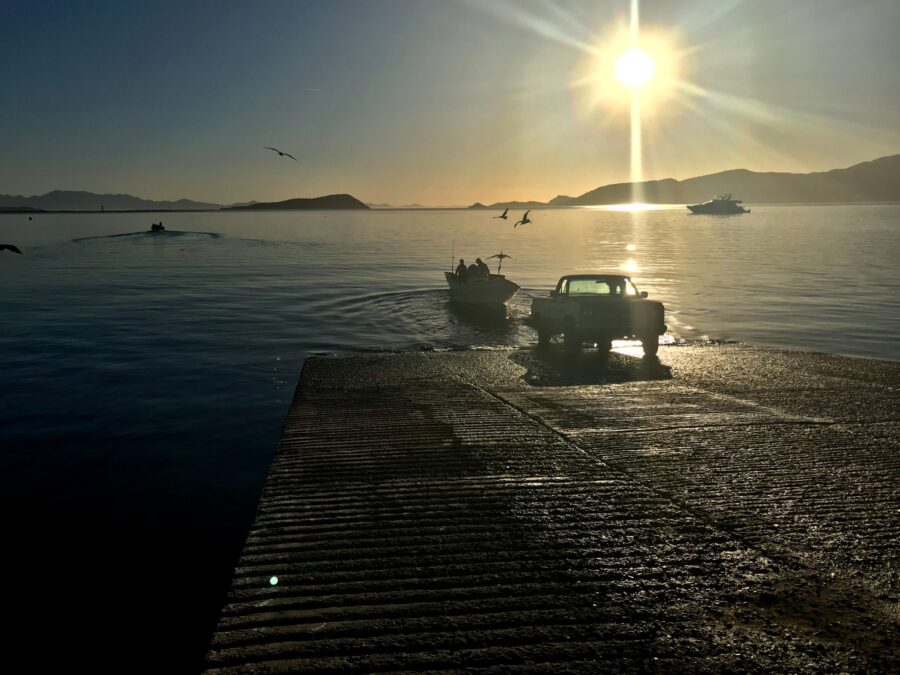
Another daybreak pic on the ramp at L.A. Bay. One after another, those pickup trucks backed up launched their boats — the open-air, fiberglass “pangas” that have been the mainstay of Baja’s fishing fleet since the 1960s. The local catch has dwindled in recent decades, but sport and commercial fishing are still the main industries in L.A. Bay.
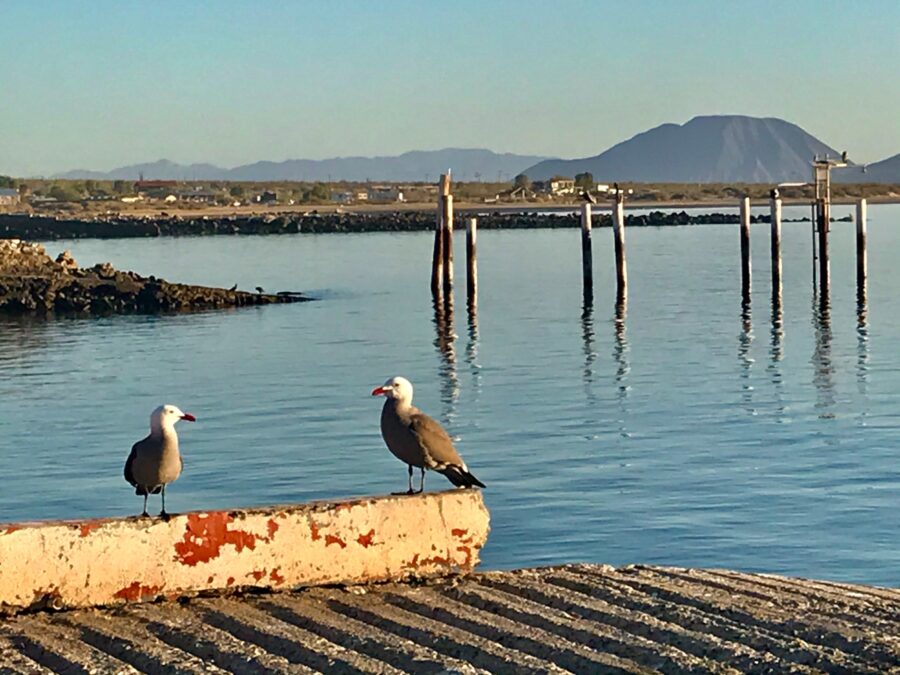
One more pic from the launch ramp at L.A. Bay, with Isla Coronado standing tall in the distance.
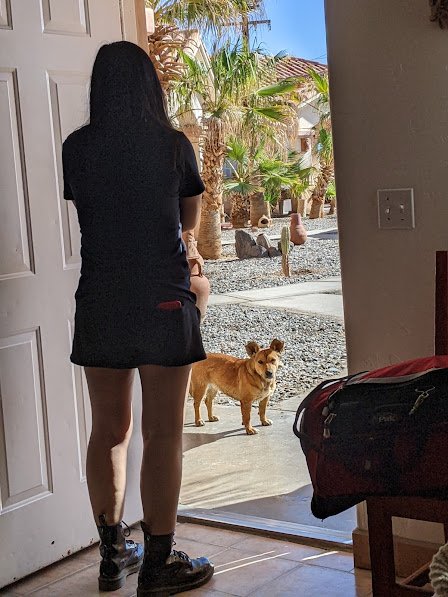
No Club Med or Four Seasons around here, but $70 USD a night will get you a clean, no-nonsense room at spots like the Costa del Sol Hotel in L.A. Bay. I’d stayed here a few times before, but not since 2006.
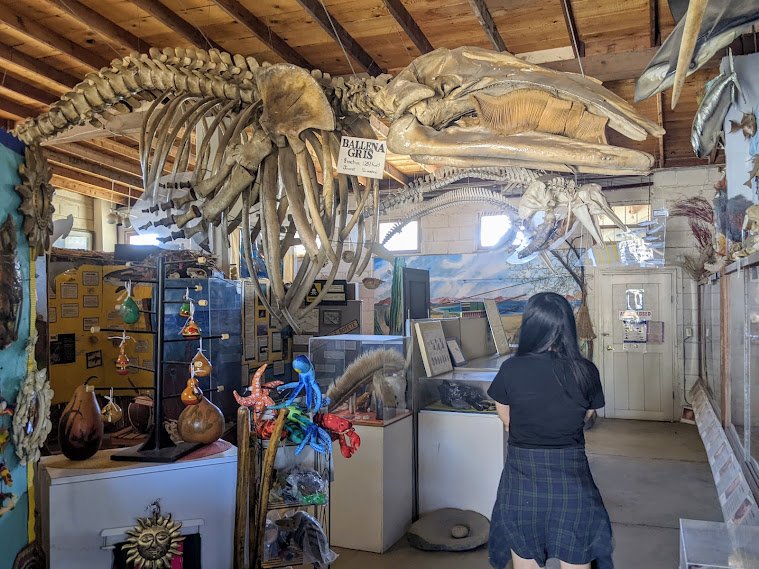
From what I’ve seen, small-town museums run the gamut, from really lame to quite cool. In L.A. Bay’s case, it is decidedly cool—modest in size but chockfull of well thought-out exhibits and well-preserved artifacts, with bilingual signage throughout. Check out the skeleton of a juvenile gray whale suspended across the ceiling.
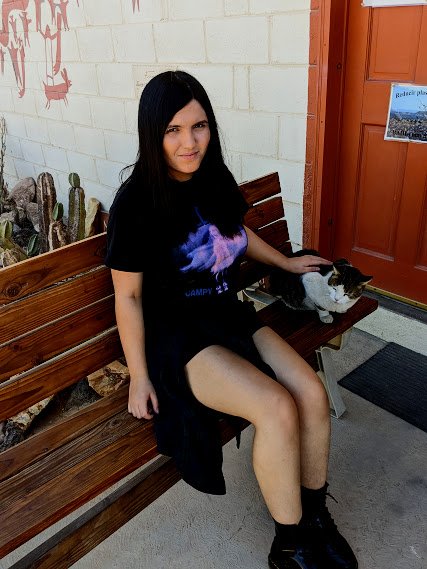
She’s more of a dog person, yes, but Emily finds four-legged amigos in many forms, wherever the road leads. In this case it was the resident cat at the L.A. Bay museum. The docents I met deserve a shout-out—a pair of older, U.S. expat ladies who had left Southern California behind and reinvented themselves in this sleepy Baja community.
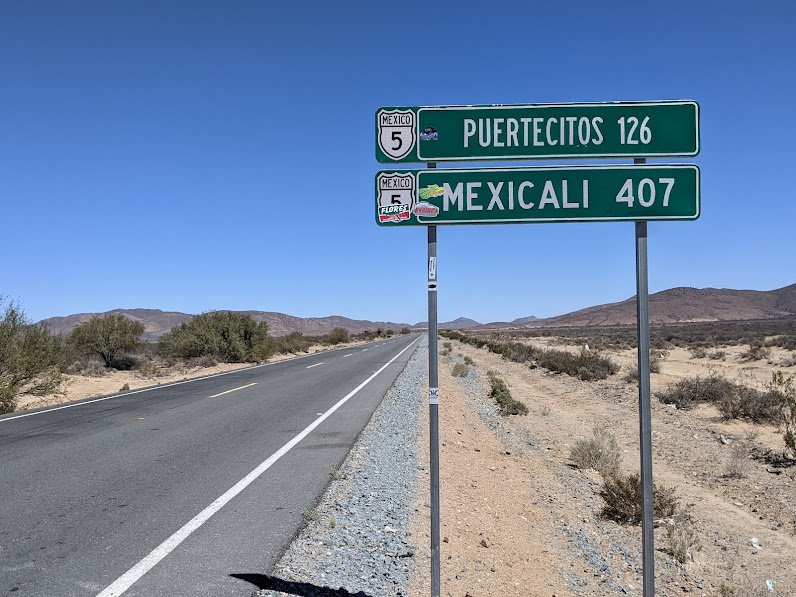
Here we have the south end of Mexico Hwy. 5, where it meets Hwy. 1, the famed Trans-Peninsular Highway, in Baja’s central desert. It used to be a long day’s drive from this turnoff to Mexicali—assuming you had a sturdy, high-clearance vehicle that could negotiate that first 75 miles (126 km.) of grueling, unpaved road. Now it’s about five hours, on one of the best paved highways in all of Baja. For motorists approaching Baja from the east, that’s a major time savings and makes it a more viable travel destination. I was surprised, however, that there wasn’t a lot more traffic. Several minutes often elapsed between passing vehicles.
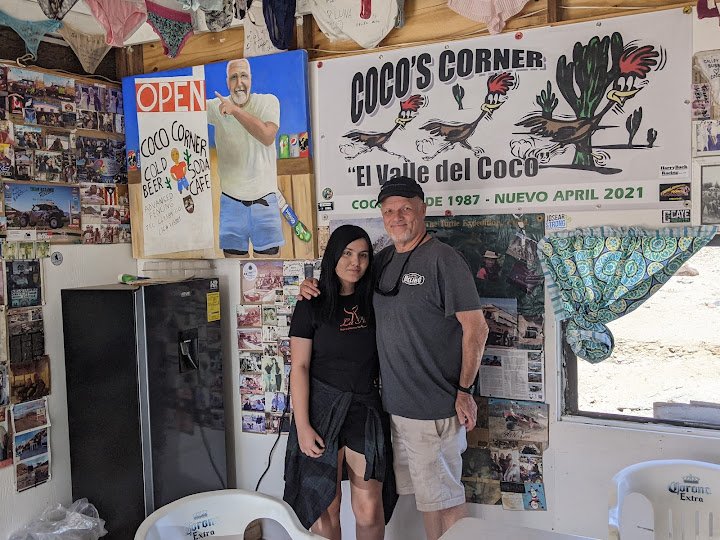
A must-stop on Hwy. 5 is Coco’s Corner. Coco (not his real name) is a dyed-in-the-wool desert rat who has lived out here since the 1960s, although his home has moved a short distance since the new highway opened. Unfortunately for us, Coco was not there when we passed through—gone to Guerrero Negro for dental work, we were told. But you can see a picture of him, dressed in white T-shirt, on the wall behind us.
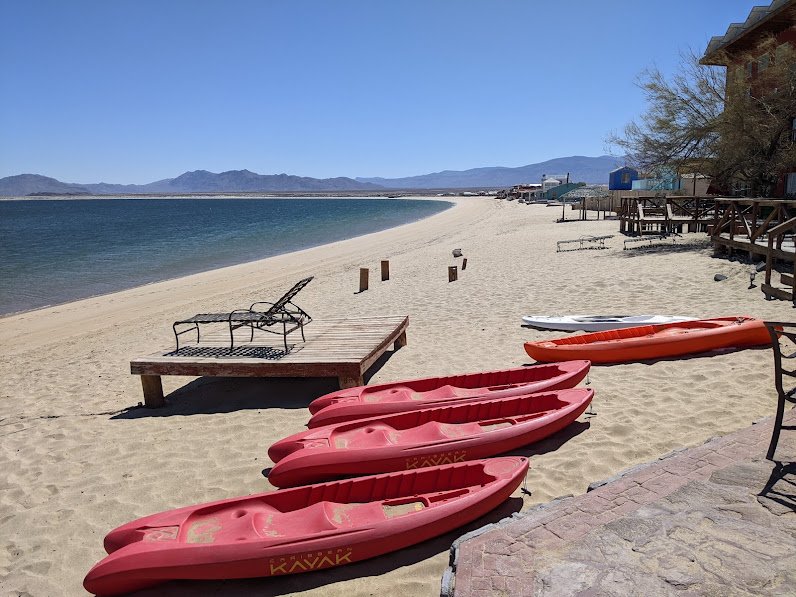
Halfway between San Felipe and L.A. Bay is Bahía San Luis Gonzaga. I call it Gonzaga Bay for short, and it ranks with the most scenic of destinations in northeast Baja. So I was truly surprised to see not a single soul on the beach. The weather was perfect, and with the new highway opened, I expected at least a small crowd here… not that we minded.
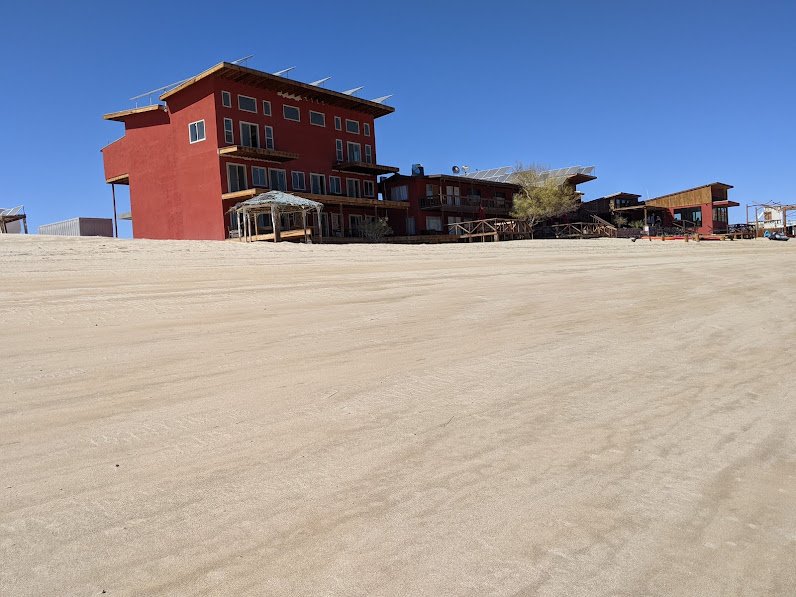
Alfonsina’s was, and remains, the main lodging place at Gonzaga Bay. For hardcore Baja explorers, this was long a well-loved retreat—a rustic, no-frills inn where four-wheelers and bikers convened and caroused after making the long dirt-road trek to this sublime locale. That may change with the completion of Hwy. 5, which cleared the way to a much wider crowd. Perhaps the owners are counting on that, as the inn had clearly undergone a major upgrade—fresh paint, new fixtures and squeaky-clean tiling at every turn, with English menus and dollarized prices in the restaurant. It almost smacked of tourist trap, but that would be too harsh. For the price of lunch (and my fish tacos were pretty good), we got to enjoy that beach all to ourselves.
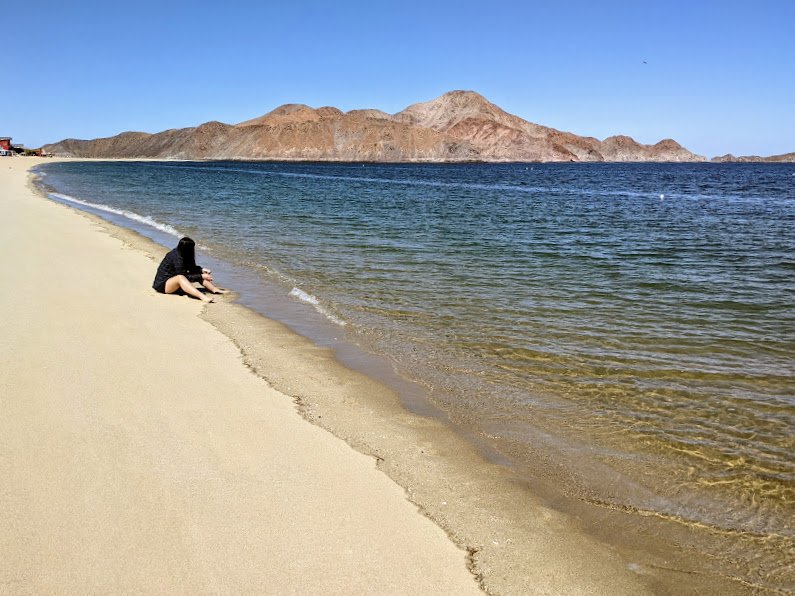
A weekday afternoon at Gonzaga Bay. First week of spring, temperatures in the 80s, water temp in the mid-70s, just a hint of breeze, and no one—I mean no one—on the beach besides us.
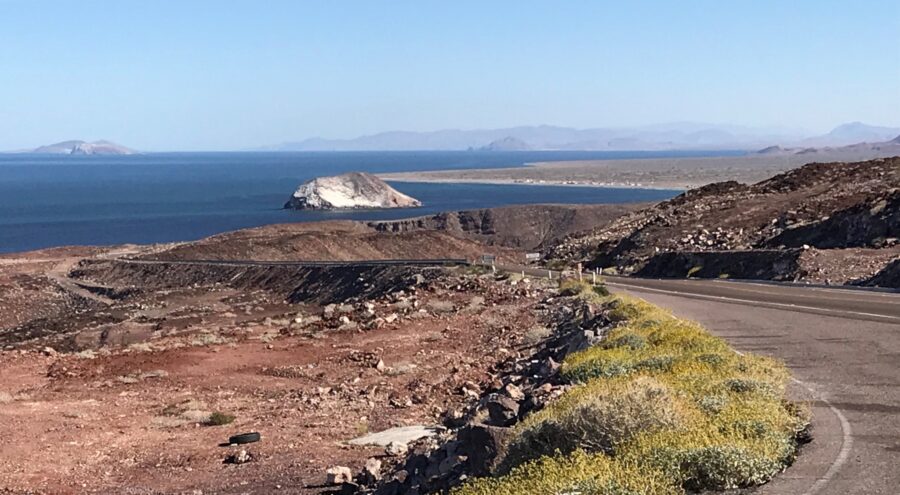
Typical view along the new Mexico Hwy. 5, between Puertecitos and Gonzaga Bay. Some will say this route has been “ruined,” now that anyone in any car can make this drive, and the unwashed masses can’t be far behind. Then again, you can enjoy the view a lot more when you’re not fretting about punctured tires, busted oil pans, etc., every step of the way. And, you can’t blame Mexico for wanting to bring in more gringos and their vaunted greenbacks.
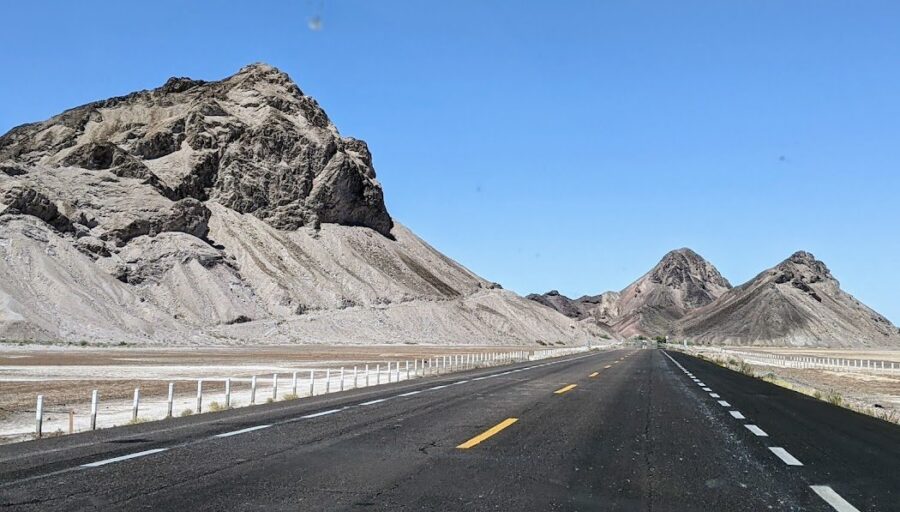
Heading north on Mexico Hwy. 5 through some whimsically shaped hills, about halfway between San Felipe and Mexicali. Smooth driving, yes, but oh, how I hate heading home from these trips.
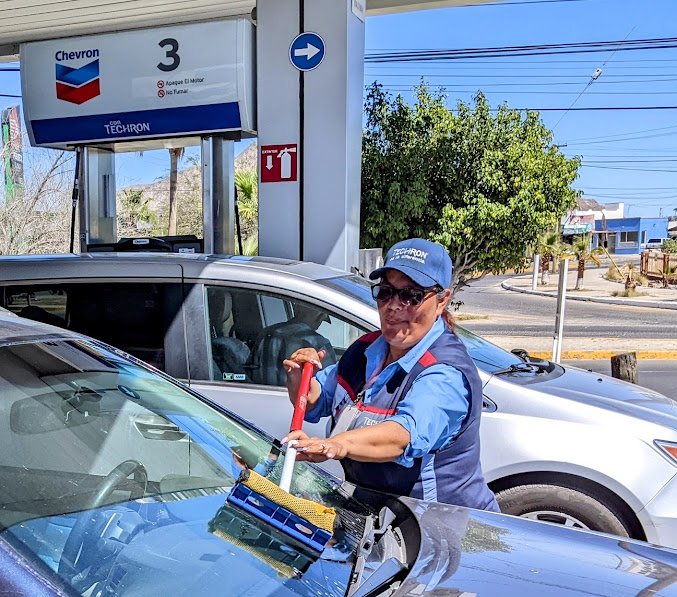
I’d barely earned my driver’s license, 1970-something, the last time someone cleaned my windshield in California! But full service is still a thing at Mexican gas stations (Chevron included!), and for a few pesos extra, they may clean the other windows and take a peek under the hood. And look who’s doing the wash-down. Girl power is also a thing at filling stations here. On this day there wasn’t an “hombre” in sight.
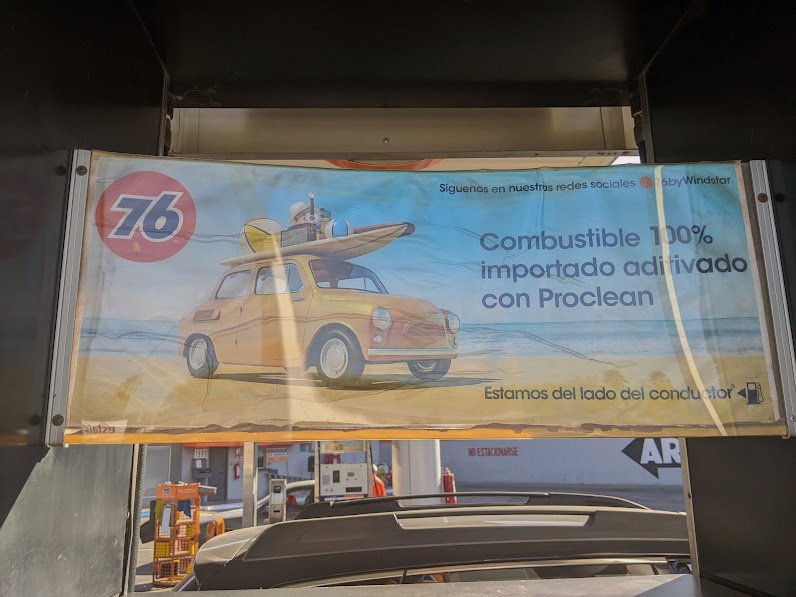
Yes, this is south of the border, but as the sign at this Mexicali station boasts, the gas is 100% imported, and fortified with a special cleaning ingredient. I topped off the tank here before crossing the border, and I bet you would have too. At the prevailing exchange rate, I paid a bit less than $4 USD per gallon—$2 less than the price in neighboring California.
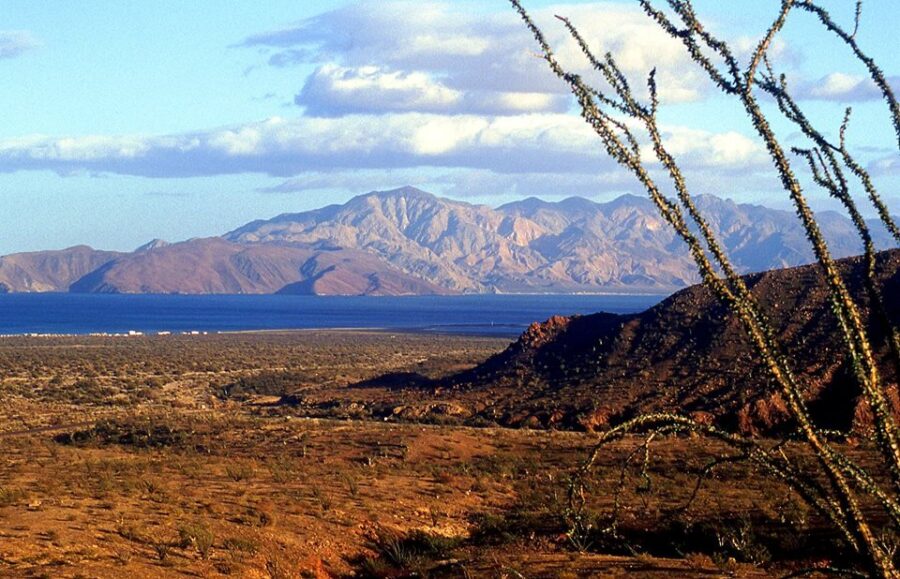
I’ll leave you with this—a picture of L.A. Bay from 1998—six years before Emily was born. I still like it better than anything I took on our recent trip, and I hope you like it too.

What a super trip report! David Brackney is a wonderful travel writer and I have enjoyed reading his work the past 20-odd years… Thank you.
What David said.
Most enjoyable read.
Still working on convincing my better-half to cross-over.
Thanks, David for your low key photo essay (not the glossy commercial variety). As a long time Baja traveller and DB member, I appreciated the update on some of my old haunts, but must confess, I haven’t been to Gonzaga Bay (yet). It looks inviting. Was there anything in the way of RV campsites, maybe with palapas like Bahia Concepcion? How bout a tienda, and/or fish vendors?
THE PICTURES MAKE YOU WANT TO BE THERE. THANKS FOR THE MEMORIES OF SAN FELIPE AND THE MEX 5 INFORMATION.
What a wonderful story and pictures of Baja. I’ve lived in San Felipe for 12. years and this story tells the real story of Baja. Thank you.
Great pictures and story.
Does Doc rent to drop in campers at Gecko? I know he stopped doing this some years ago.
Sorry, but I don’t know one way or the other.
After driving up/down Baja 30+ times but never stopping at LA Bay, my road trip buddy and I will correct that grieving mistake soon in June of 2022. Thx be to David Brackney for the inspiration.
After driving up/down Baja 30+ times but never stopping at LA Bay, my road trip buddy and I will correct that grievous mistake soon in June of 2022. Thx be to David Brackney for the inspiration.
Phil DuBois: Please send your own trip report . . . would especially love to hear about any whale shark sightings.
Phil DuBois: Please send your own trip report . . . would especially love to hear about any whale shark sightings.